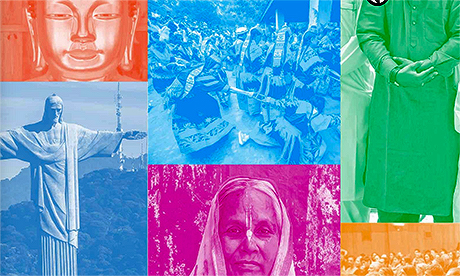If you think religion belongs to the past and we live in a new age of reason, you need to check out the facts: 84% of the world’s population identifies with a religious group.
Members of this demographic are generally younger and produce more children than those who have no religious affiliation, so the world is getting more religious, not less – although there are significant geographical variations.
According to 2015 figures, Christians form the biggest religious group by some margin, with 2.3 billion adherents or 31.2% of the total world population of 7.3 billion. Next come Muslims (1.8 billion, or 24.1%), Hindus (1.1 billion, or 15.1%) and Buddhists (500 million, or 6.9%).
The next category is people who practise folk or traditional religions; there are 400m of them, or 6% of the global total.
Adherents of lesser-practised religions, including Sikhism, Baha’i and Jainism, add up to 58m, or well below 1%. There are 14m Jews in the world, about 0.2% of the global population, concentrated in the US and Israel.
Nones
But the third biggest category is missing from the above list.
In 2015, 1.2 billion people in the world, or 16%, said they have no religious affiliation at all.
This does not mean all those people are committed atheists; some – perhaps most – have a strong sense of spirituality or belief in God, gods or guiding forces, but they don’t identify with or practise an organised religion.
Almost all religions have subdivisions.
Christians can be Roman Catholic (the biggest group with almost 1.3 billion adherents), Protestants, Eastern Orthodox, Greek Orthodox, Anglican or many other sub-denominations.
Muslims might be Sunni (the majority), Shia, Ibadi, Ahmadiyya or Sufi. Hinduism has four main groups: Vaishnavism, Shaivism, Shaktism and Smartism.
There are two main traditions in Buddhism – Theravāda and Mahayana, each with subgroups. Jews can be Orthodox (or ultra-Orthodox), Conservative, Reform or belong to smaller groups.
Geography
Geography is important in religion. Asia-Pacific is the most populous region in the world, and also the most religious.
It is home to 99% of Hindus, 99% of Buddhists, and 90% of those practising folk or traditional religions.
The region also hosts 76% of the world’s religiously unaffiliated people, 700m of whom are Chinese.
Three-quarters of religious people live in a country where they form a majority of the population; the remaining quarter live as religious minorities.
For example, 97% of Hindus live in three Hindu-majority countries: India, Mauritius and Nepal, while 87 %% of Christians live in 157 Christian-majority countries. Three-quarters of Muslims live in Muslim-majority countries.
Among the religiously unaffiliated, seven out of 10 live in countries where they are in the majority, including China, the Czech Republic and North Korea.
In contrast, most Buddhists (72%) live as a minority in their home countries.
There are seven countries where Buddhists form the majority of the population: Bhutan, Myanmar, Cambodia, Laos, Mongolia, Sri Lanka and Thailand.
Which religions are growing, and where?
The short answer is religion is on the wane in western Europe and North America, and it’s growing everywhere else.
The median age of the global population is 28.
Two religions have a median age below that: Muslims (23) and Hindus (26). Other main religions have an older median age: Christians, 30; Buddhists, 34 and Jews, 36.
The religiously unaffiliated come in at 34.
Islam is the fastest-growing religion in the world – more than twice as fast as the overall global population. Continue reading
- Image: The Guardian
